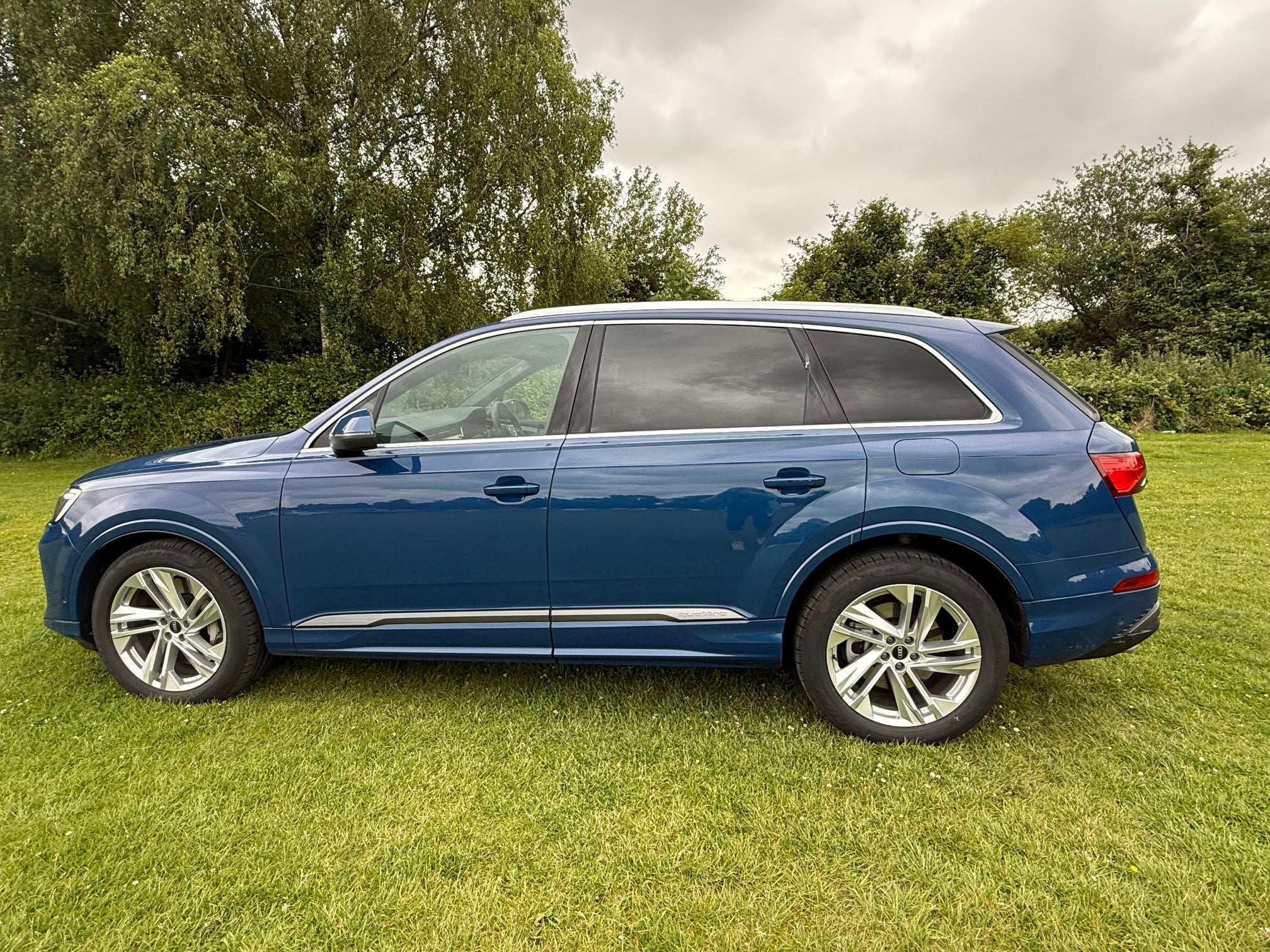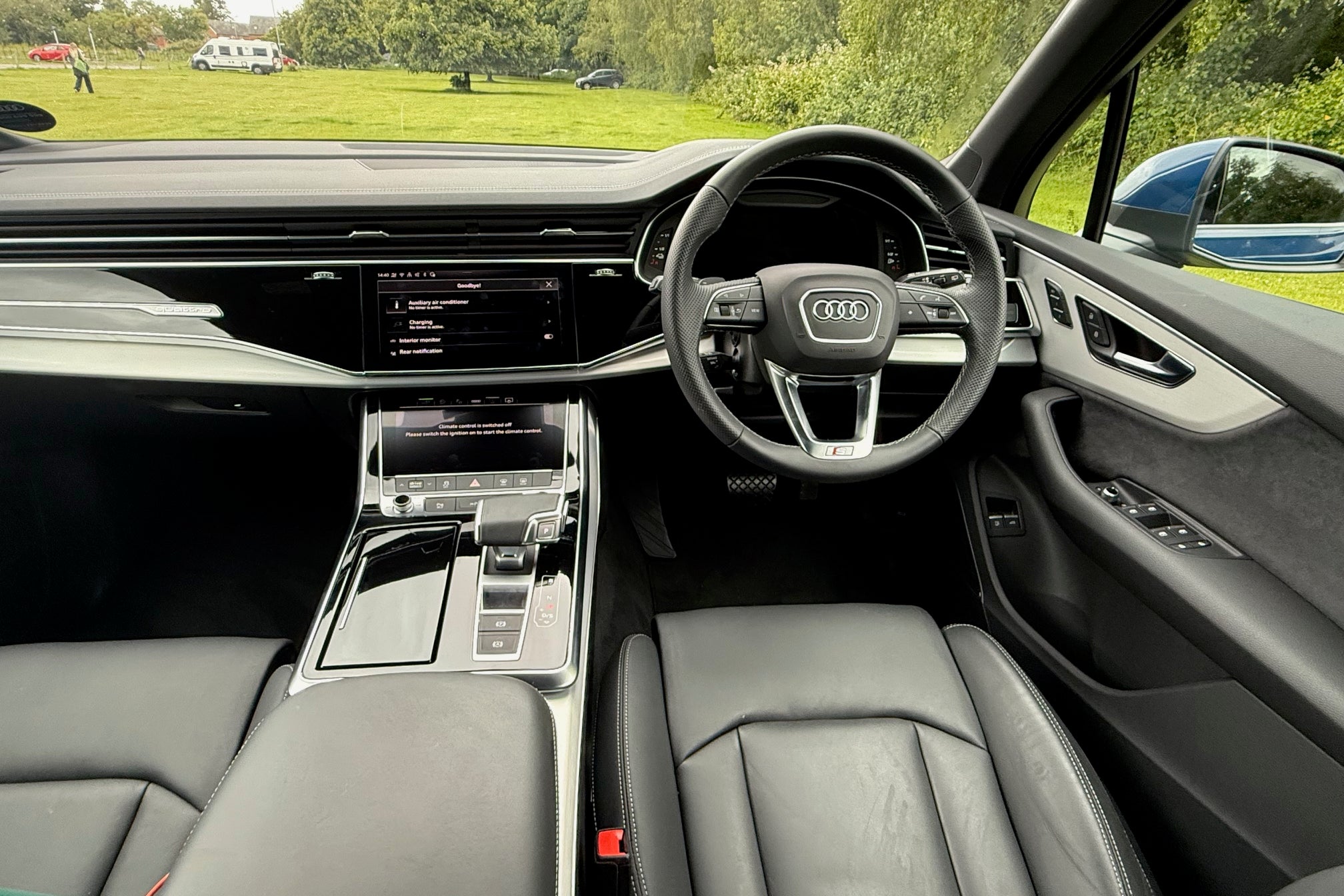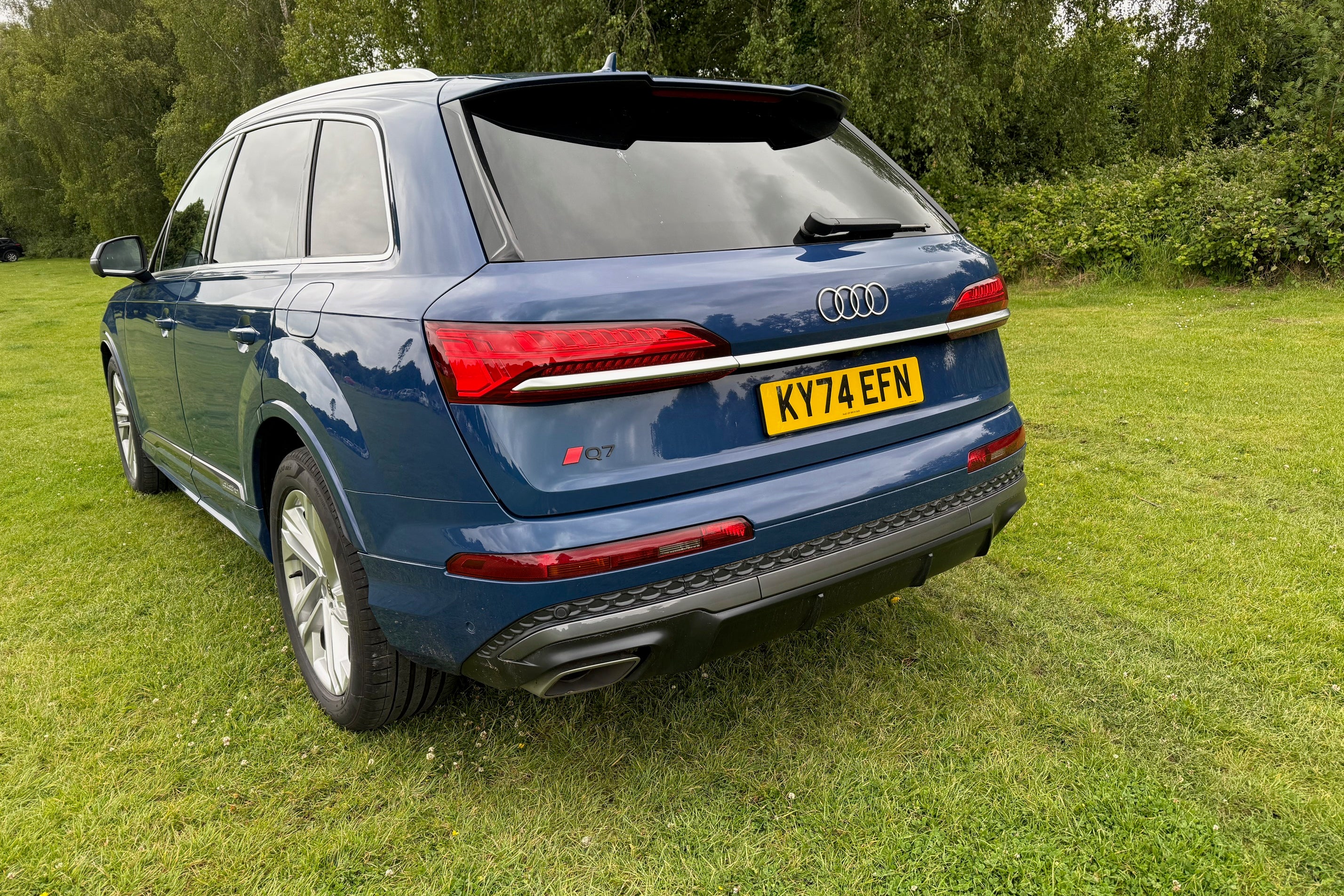
The Audi Q7 is a full-sized family SUV that’s packed with all the bells and whistles imaginable. It is available with plug-in hybrid technology which is good news for fleet buyers as it lowers the carbon emissions figure and makes for more rewarding Benefit in Kind tax savings.
And for anyone thinking it will be hampered by the added weight of the PHEV powertrain, we should point out that the car is powered by a 3.0-litre V6 petrol engine. It also features Audi’s highly-rated quattro all-wheel drive set-up which, along with a towing limit of 3.5 tonnes, makes it ideal for family caravanning holidays.
We can’t possibly consider talking about the Q7’s design without first mentioning that grille – it’s simply huge and could prove the marmite factor for many would-be buyers. Whenever I see it, I think whale shark cruising along, mouth gaping and scooping up the plankton. Additionally, there are over-sized Audi rings plonked right in the middle, along with lighting clusters down each flank as if to highlight the feature. Styling is completed by snazzy 20-inch alloy wheels, privacy glass, body-coloured mirrors and door handles, plus lots of chrome trim.
While the Q7 has long been considered the German carmaker’s flagship model, alongside the more recently-launch Q8, it is up against fierce competition these days. The large SUV sector has grown considerably and there are some fabulous contenders out there vying for sales. Audi owners do tend to be quite loyal to the brand, although they may just be tempted by the allure of something even more prestigious, such as the Porsche Cayenne. Only time will tell.
How we tested
I clocked up more than 500 miles behind the wheel of the Audi Q7 PHEV on a varied road route, checking out the on-board tech and seeing how the large SUV coped on narrow country lanes, dealt with city centre parking and how well it cruised on motorways.
Audi Q7: From £77,135, audi.co.uk

Independent rating: 7/10
- Pros Refined, comfortable, posh and has a V6 engine
- Cons Heavy, EV range is no match for some rivals, looks tired in places
Audi Q7 Specs
- Price range: £77,135 to £99,735
- Battery size: 22kWh
- Maximum EV range: 51 miles
- Engine: 3.0-litre V6 petrol
- Claimed battery & engine range: Over 4,000 miles
Battery, range, charging, performance and drive
Powering the Audi Q7 PHEV is a 3.0-litre V6 petrol engine and a 22kWh battery that delivers an EV-only driving range of 51 miles. While that would easily cover the average daily commute, 51 miles is a tad ambitious if any faster roads are en route, where the range will drop like a stone. But if you can charge the battery regularly and make the very most of those EV miles, you will see a good return on the efficiency front – but it would take a miracle to get close to the official figure of 217.3mpg.
The Q7 PHEV has 340PS and 500Nm of torque resulting in quick pace out the starting blocks. It can sprint from a standing start to 62mph in just 5.7 seconds and onto a maximum speed that is electronically limited to 149mph. That’s not too shabby for a heavyweight in the sector topping the scales at more than 2.3 tonnes.
Our extensive test routes incorporated a mix of country roads and motorways with some congested stop-and-go city driving along the way. Firstly, the Q7 is a most accomplished motorway cruiser. You can sit for hours on end eating up the miles without getting fidgety or craving for a break. That’s because the ride is cushioned thanks to the adaptive air suspension, the seats are supportive and the car has adaptive cruise control for added convenience too.
On narrower lanes, it feels over-sized at times and its not as nimble as some rival models. The acceleration through the eight-speed automatic gearbox is smooth enough and there are paddles for added driver engagement, but you need wider roads to fully explore them to the max, as is the case with the drive modes called Efficiency, Comfort, Auto, Dynamic, Individual, Off Road and All Road. These alter the characteristics and performance but, in all honesty, most owners will probably investigate the various responses when the vehicle is new and then find their favourite setting and stick to it.
But if you are venturing away from the smoother tarmac, it’s easy to raise the ground clearance to prevent any damage.
The strength of the regenerative braking is controlled automatically according to the driving style and conditions, but it is possible to manage the EV range via settings called EV Only, Auto Hybrid, Battery Hold and Battery Charge.
Special mention to the good all-round driver visibility, a factor that will score highly with mums and dads running the daunting school run gauntlet on a regular basis. But you will need a large parking space to accommodate the Q7 which stretches almost 5.1 metres in length.

Interior, practicality and boot space
With a mix of high-quality materials and upmarket fixtures and fittings, the Q7’s cabin is a nice place to be. The powered seats, along with the steering wheel, can be warmed against the winter chills, and there are memory settings to store favourite driving positions, which is ideal if the vehicle is shared.
The Q7 has space for all the family, but there is a price to pay for the plug-in hybrid technology. The batteries eat into available space and, as a result, the two compact rear seats on traditionally-powered Q7 models are lost. So, you will have room for five, not seven and that could be a compromise too far for some customers.
But you do get ample storage space with a boot, accessed via a powered tailgate, able to swallow 563 litres of goodies, increasing to 1,863 litres with the split-folding rear seats dropped flat. This is more than some rivals such as the VW Touareg and should be ample for transporting golf clubs and trolleys, or suitcases on family holidays.
Additionally, you get plenty of handy storage compartments scattered throughout the cabin, including a glovebox that locks, central cubby, wireless charging pad with USB-C ports, deep door bins, seat back nets and some handy trays.
Up front, there’s room for two six-foot-plus adults to sit comfortably and another two will fit behind them too. Alternatively, a trio of youngsters will fit side-by-side on longer trips without too many complaints.

Technology, stereo and infotainment
There is plenty of on-board tech to explore within the Audi Q7 and it’s designed in a user-friendly manner too, which we like. The 10.1in infotainment screen is integrated into the dashboard with a second 8.6in screen beneath it housing the climate control settings. There is a third panel behind the multi-function steering wheel clearly displaying the important driving data and this can be customised to taste.
Connecting a smartphone via Apple CarPlay or Android Auto is effortless and there is plenty of on-board tech to get stuck into. Creature comforts include a navigation set-up, Bluetooth and DAB radio. Our car had an additional Technology Pack and that introduced a pitch perfect Bang & Olufsen sound system, 360-degree camera, Park Assist and a head-up display
The touchscreen interface is intuitive and easy to navigate, and the chunky gear lever is another stylish feature.
The only negative point is how dark the cabin seems. There is no sunroof and the upholstery, dashboard, door panels and centre console are all black. There is some light coloured contrast stitching to the seats, but that’s about it. It all looks a bit sad, drab and dated in places.
Prices and running costs
The Audi Q7 Plug-in hybrid (or Q7 55 TFSI e quattro to give it its official name) is available in three richly-equipped trims called S line, as tested priced from £77,135. The Black Edition costs from £81,685 and the top-of-the-range Vorsprung version will set you back £99,735.
But Audi, like every other premium carmaker, offers a whole raft of optional extras and packs that really ramp up the final price-tag. Our car featured specialist Ascari blue metallic paint, a Technology Pack and Tour Pack. These extras bumped the price up by a further £6,240.
The official combined fuel figure (like that on most PHEV models) is pretty impossible to match. It is WLTP-tested, but 217.3mpg would only be achievable if the 51-mile EV range was used regularly and the car’s battery kept topped up to the max.
And due to the high cost of the Audi Q7, buyers will be subject to an Expensive Car Supplement applied to vehicles costing in excess of £40k. This results in a charge of £425 from years two to six.
Audi Q7 rivals
- BMW X5
- Volvo XC90
- VW Touareg
- Porsche Cayenne
FAQs
How long does it take to charge?
The Audi Q7’s 22kWh battery can be charged from 0-100 per cent in 3 hours, 45 mins via a 7.4kW wallbox
How much does it cost – is it worth it?
Our entry-level Audi Q7 S line model was priced at £77,135, but as is the premium car way, it featured a whole bundle of optional extras totalling £6,240.
Does Audi replace batteries for free?
There’s an eight year or 100,000-mile warranty for the Audi hybrid battery pack, with standard three-year, 60,000-miles cover on the rest of the car.
Why trust us
Our team of motoring experts have decades of experience driving, reviewing and reporting on the latest EV cars, and our verdicts are reached with every kind of driver in mind. We thoroughly test drive every car we recommend, so you can be sure our verdicts are honest, unbiased and authentic.
Verdict
The Audi Q7 seems to have been around since the invention of the wheel and is a well-renowned family SUV. The petrol V6 engine with added EV power offers good, although not blisteringly quick pace, but the refinement and comfort make up for any shortcomings. It’s also a very practical beast, despite showing its age in places.
EV prices edge up as demand increases
What happens if your electric car breaks down? The AA has the answer
The Independent EV Price Index October 2025
The 10 best Tesla alternatives 2025: Our favourite rivals to Elon Musk’s EVs
Electric car drivers could face new pay-per-mile tax under Treasury plans
Suzuki e Vitara review: Bags of charm, but behind the times on tech







